Warhammer 40,000: Space Marine Review for Windows PC

Dark Grimness
There may be some people out there who don’t spend every bit of money they can on tiny plastic space men, or every waking hour painting and battling with said plastic space men and therefore do not know what Warhammer 40,000 is. These are people who have do not have their priorities in order.
Warhammer 40,000 is an unendingly grim science fiction universe set in the 41st millennium. Humanity spans the stars across endless worlds in a sprawling, dogmatic and repressive galactic empire known as the Imperium. Beset on all sides by the horrors of the galaxy, life is often short, brutal and filled with thankless toil for its people, who venerate the Immortal God Emperor, who has sat between life and death on the golden throne for ten millennia.
First among humanity’s defenders is the most iconic element of WH40k - the Space Marines. They are genetically enhanced warrior monks who double as walking tanks. Space Marine as a game was going to live or die on how well it translated techno-knight supermen from the far future into the digital medium; well thank the Emperor, because Space Marine does Space Marines justice. Brutal, blood-drenched justice.
Ultramarines - Always Feeling Blue
Warhammer 40,000: Space Marine places players as Captain Titus of the Ultramarines, tasked with delaying an invasion of a forge world by green cockney space hooligans, or “Orks”.
From the opening moments, with your nuisance squad mate reminding you that jumping out of an aircraft mid flight contravenes the Codex Astartes, or ‘Big Book of Being a Space Marine’, the game has no qualms about reminding you time and again which universe events take place in. Little touches like the servo skull audio logs that explore the trials of common folk across the planet reacting to the invasion gives a flavor of the totalitarian structure of the Imperium and the cruel, unforgiving nature of the universe. Big touches like fighting across a 100ft Imperial Titan bipedal war machine scream the scale and scope of the setting into your face. While the setting is treated more as flavor than deep exploration, it is slavish and takes great effort to anchor the game into the WH40k universe. This would all be for naught however if Warhammer 40,000: Space Marine didn’t properly convey the power of the power armored legions.
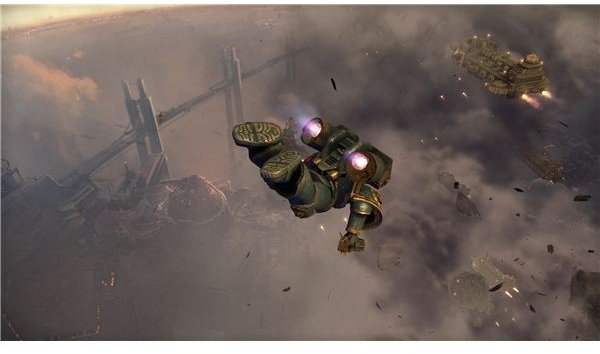
In the fiction of WH40k, Space Marines are all one man armies in their own right and Warhammer 40,000: Space Marine repeatedly, gorily hammers home that aspect of them. Even before the blood flows, you really get a sense of superhuman might from the way Titus carries himself in lumbering, yet fluid gait. His footfalls make him sound as heavy and huge as he looks, as he purposefully stomps about. The screen even shakes when he sprints.
Not least of all is the way he shuns even the idea of cover, because he is his own cover. It soon becomes obvious that the game is less a third person shooter and more a third person crusade against the enemies of man. The biggest component of it is fearlessly wading into small armies of foes and victoriously cleaving through them.
You Know What Gets Blood Out? More Blood!
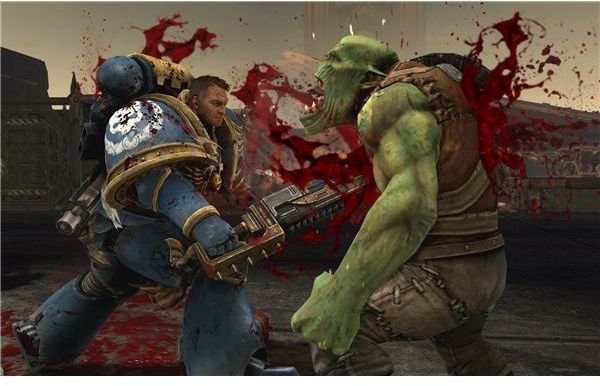
Once battle is joined, it won’t be long until anything and everything is awash with blood as Titus barrels into, stomps, rends, chops, punches to death and even pulls apart the heads of filthy xenos. This game wants you to feel as powerful and as remorselessly, impassively violent as its subject and it does a fine rendition of it without the costly course of steroids and the hassle of covering yourself in the necessary amount of jagged edges you’d otherwise encounter.
The game’s centerpiece is its melee combat. When not smashing through (systemless) cover like a living wrecking ball, the combat system is fairly straight forward using a mix of slash and stun moves to form fluid manoeuvres that give way to one of the big features of the game - executions; a hyper violent way to both dispatch your enemies and regain health, allowing you to stay in the fight longer.
You take damage during executions, so a big part of the game becomes choosing your opportunities and understanding the rhythm of the combat against a numerically superior foe. It can be frustrating, but when it gets it right, Space Marine gets it really right.
Of course no Space Marine would go to war without an arsenal, and all the tools of the trade that a glorious servant of the Emperor would expect to wield are present and brought to vicious, righteous life.
Rapid Fire
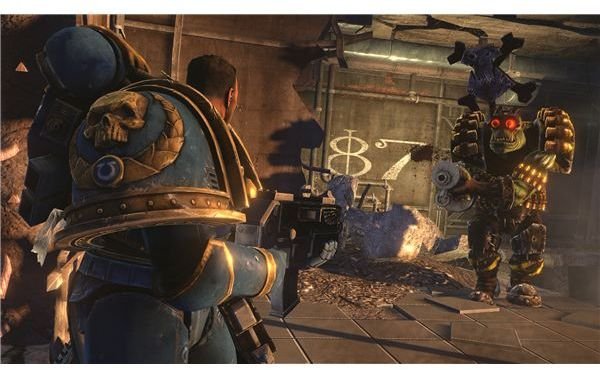
The chainsword, the bolter, the thunder hammer, the melta gun, the jump pack; all the wargear is satisfyingly faithful in how it’s envisioned. The weapons are given a weightiness and feel that imbues each and every one with its own character and thanks to the excellent sound design, come across in a huge and vivid way. The bolter especially, perhaps the Space Marine’s most iconic weapon, is lovingly well realised and handles just exactly as its many depictions in fiction, from the impression of its sturdy kick and deadly stopping power to the stunted roar of its use.
While enjoyable on its own merits, the big pull of Space Marine for many will be the way it brings the 40k universe to life. It’s a shame that some of the truly novel game play elements that this brings aren’t more prevalent. The jump pack scenes are some of the most enjoyable parts of Space Marine; enough so that I wish more of it was dedicated to stomping on Orks from high altitude, like a demented, jet-powered Super Mario.
Diabolis In Extremis
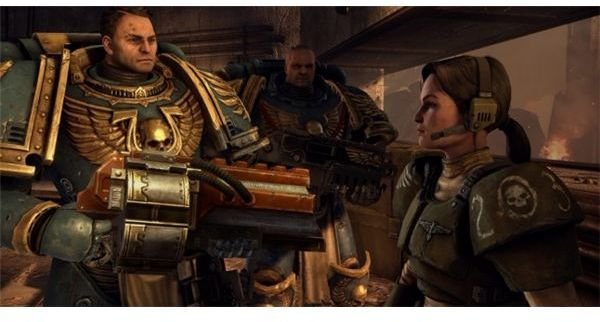
It’s not all good though, Space Marine definitely has some flaws. The story is formulaic and not very interesting. The dialogue is also mostly not that great and the characterizations tepid, although that falls under the debate for whether space marines can ever be interesting characters. While the core gameplay mechanisms are good, they can get a bit repetitive in light of there not being enough opportunities to use them in different ways and there not being enough set pieces. There’s a distinct deficit of vehicles, for example. WH40k is filled with strange and deadly contraptions, like murderous tin cans, or walking tombs, or floating pirate ships and all the other kinds of bizarre, exaggerated things that makes WH40k, WH40k. I’d be embarrassed if my game was outclassed in certain respects by Fire Warrior.
Speaking of bland, brown shooting games, a common complaint is that Warhammer 40,000: Space Marine can appear to be just another brown third person shooter. Well, it’s a valid complaint; there are a lot of brown environments. There’s a perfectly valid story reason for that, with the game taking place on a forge world, a planet devoted wholly to manufacturing, but it could have done with a little more variation here and there.

Even the scale and grandness of the setting occasionally works against the game at times: You have this entire world filled with vast, intricate gothic architecture and a teeming workforce population. The citizens are nowhere to be seen for one reason or another, so a lot of the time, Titus is running down these empty corridors, which makes it seem like nothing is going on between battles.
Maybe that’s allegorical for battle being all for Space Marines and all else being hollow and empty, but I really doubt that is the case; up until the time Relic reads this and hires me for their PR department.
Rites of Activation - Controls & Interface (4 out of 5)
The

controls are well implemented in general. Occasionally, I’d forget what key did what, but that’s more of a personal problem. There aren’t even that many keys to remember. In its simplest terms, combat can boil down to left mouse button to shoot, right mouse button for melee, with a few other keys on top of that. The combat is more about flow of movement than complex combos and the controls reflect that.
The interface is quite minimal too. There’s health bar, ammo counter and an Ultramarines symbol and that is all. When an ‘event’ is happening, small prompts come up. During actual quick time events, they got in the way of seeing the event unfold, because you’re too busy looking for key instructions. This is a complaint against quick time events, more than intrusive key prompts.
The minimal nature of the HUD accentuates the cinematic approach the game is going for, though I was kind of disappointed that there weren’t more in-game references to the myriad of tactical data that Space Marines go in to battle with. That might have been cool. It might also have been confusing, considering Titus doesn’t wear a helmet.
Battle Cries - Sound (5 out of 5)
The sound design in Space Marine is stellar. It is really, really good. It deserves a great deal of the credit for making the world, the weapons, even power armor sound as authentic and convincing and as right as they do. The exceptional sound design vies with the perhaps even more exceptional score for the honor of the Crux Terminatus; and induction into the Hall of Honor. I mean, best… noisy…thing. Yeah…

The music is all played by an actual, physical orchestra, which is a welcome change from the usual exclusive use of samples in game music. The orchestra adds a layer of nuance that otherwise wouldn’t be there. Initially my opinion was that the score seemed too restrained, considering how Space Marines are always going on about glorious battle and righteous fury and such. That opinion is patently wrong. Maybe it’s the in game mix, maybe it’s my sound setup, or maybe I was just too focused on killing xenos, but I didn’t realize, until I actually took the time to properly listen to it, that the score is incredible. It’s the right mix of grim, dour atmosphere and strident, catchy melody and motif that has honor, duty and grandiose struggle written all over it. There are a great many big budget film scores that aren’t as good as this, but the trillions of dollars it must have taken to make it a reality was well worth it and then some.
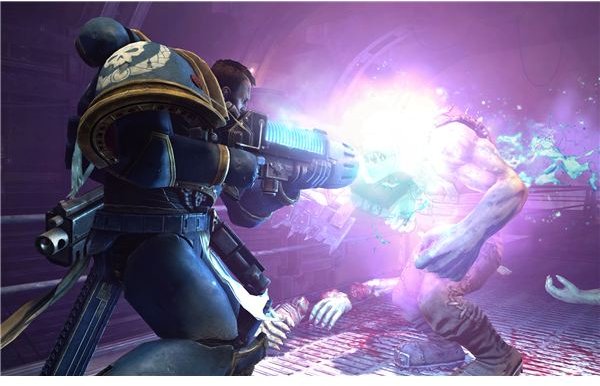
On the subject of “things that contributed to sapping the budget of the project” the voice acting hosts famous, expensive and famously expensive actor Mark Strong. He gives Titus an air of quiet dignity and steely resolve that fits the character, though his grunts of exertion that pop up throughout the game sound…weird. I’ve never heard someone driven to the point of strain sound so disinterested. The dispassionate and stoic disposition is suitable for a character to whom war is as natural as breathing, though some zeal might have been nice. A little religious fervor never hurt anyone. The script could be better, but he does a good reading of it.
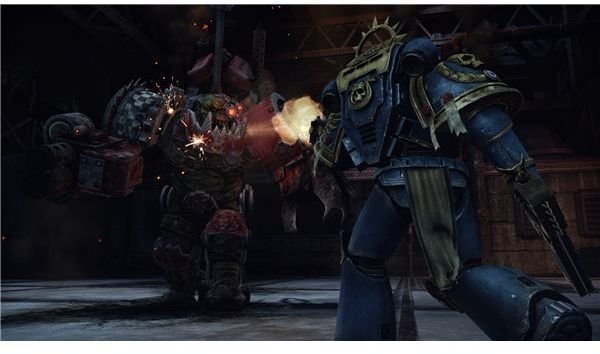
While the Orks are the requisite amount of overwrought monster cockney, it’s a shame they don’t have the personality they did compared to the Dawn of War games. Only the warboss was recognizably of the Orks we all know and (don’t) tolerate (in our galaxy). It doesn’t help that they all repeatedly yelp “SPACE MARINE!” over and over, which is far too cogent and accurate for Orks. Not enough talk of krumping and ‘umies and dakka for my taste.
The best voice acting in the game is in the audio logs that you find, which cover different areas of Imperial citizenry on planet Graia and most sound like real, believable people. It’s details like this that make Relic seem like the perfect choice to develop 40k games.
Put Some More Skulls On It - Graphics (4 out of 5)

The visuals are good. At times, they’re very good, but ‘great’ has been redefined by titles like The Witcher 2. From a technical stand point, this is a good thing, as Warhammer 40,000: Space Marine is optimized well and runs without issue on the highest settings for most midrange systems, even with literal armies on screen.
The art direction captures the scale and science fantasy of the setting and portrays it in a way that is as close to realistic as the setting has come to date (including Ultramarines: The Movie, now let us never speak of it again). The character models for the marines both look and move as convincingly as they ever have; considering they’re 8 foot super soldiers wearing tonnes of metal armor, this is a laudable feat.
All the character models have a lot of detail and distinct personality; in their design, animation and relativity to each other. Compare a Space Marine to a lowly guardsman and the marine is a giant who carries himself with austerity and discipline, whereas the guardsman is a realistically proportioned human who is tiny in comparison and slouches. Though the animation is good, there are some clipping issues, but it’s a minor problem in comparison to some of the glitches I wish Relic would actually go out of their way to patch.
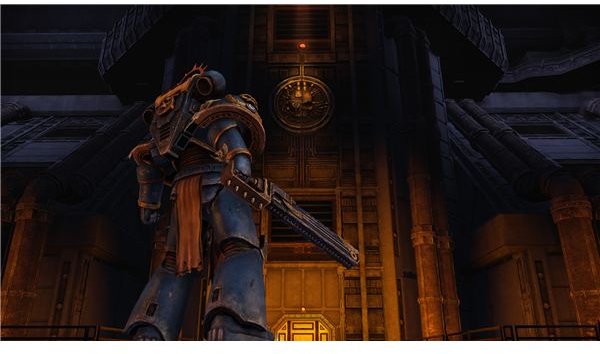
While the environments are mostly gray and brown, the art direction does capture the feel of the setting - oppressive, imposing and utilitarian; like if church met state and they both told you to get to work. The architecture, when not in copious amounts of rubble, is mostly ornate gothic factories; which again, is perfect in terms of conveying the lore, but there’s no denying that seeing variations on the same interior time and again can become more monotonous than it need be. It seems like an inescapable danger of placing a game in a forge world that the interiors will be repetitive because the planet is nothing but identikit factory/churches.
Purge the Unclean - Gameplay (4 out of 5)
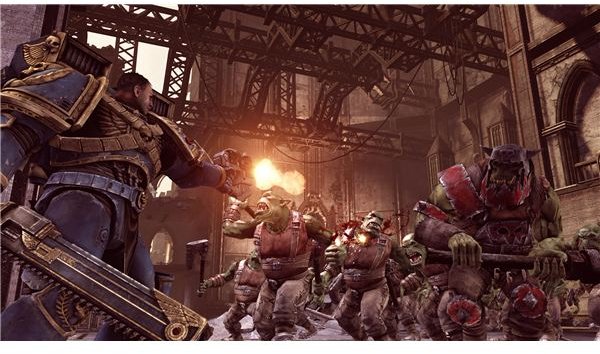
There’s a bit in the previous 40k game, Dawn of War 2, where the marines are talking about how going into battle starts off as a great thrill but over time becomes something purer, where they go to a place where body and spirit are one. During Space Marine’s peaks, it reaches a place like that, or the video game equivalent. It’s just so unashamed and honest; it’s a game about messily, mercilessly cleaving aliens and heretics in half and it doesn’t pretend to be anything else. It’s also the antidote to the recent glut of cowering behind wall simulators.
Individually, most of the gameplay elements are satisfying and well implemented, but together they’re more than the sum of their parts. Thinning down an oncoming horde with ranged (and authentic) 40k weaponry blends organically into visceral, intuitive melee, as foes pile on and encircle Titus, only to be smashed aside.
It can be very frustrating though. Executions can take a lot of time to perform, and you still take damage during them, so while Titus is busy showboating, that’s plenty of time to end up dead. It’s reasonable that you aren’t invincible and that you be aware of your surroundings, but it’s still annoying. I also find it difficult to believe that Space Marines, masters of combat they are, don’t know how to block. Surely part of being an invincible warrior is learning how to counter attacks? Yes, part of the novelty is that Titus can shrug off near any blow, but its absence is glaring at times.
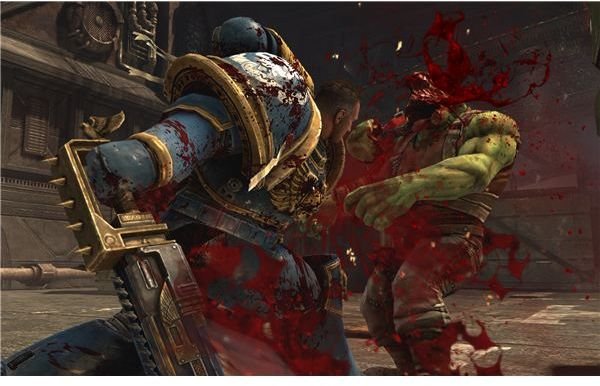
Ironically, these issues come back to the haunt the game during its last third when you are forced to use cover, because Chaos doesn’t mess around (you knew they were coming anyway, stop complaining). Thematically it makes sense, but you definitely feel less like an invincible warrior, because you’re fighting other invincible warriors, so it’s a mixed bag in the sense that it offers a better challenge and is logically consistent in terms of the lore, but compromises the game’s strong points in some ways. Fighting other marines can be a war of attrition over a clash of skill. Lastly, the final boss battle, though it looks good, is disappointing. There’s an extremely challenging, well designed run up to it, then an extended quick time event. This is the game’s biggest missed opportunity.
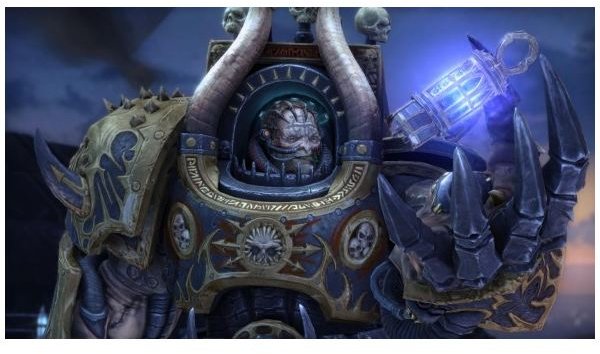
Most of these shortcomings vanish in the multiplayer however, which aside from irritating lag issues, is focused and honed and very compelling. It could do with more game modes and a greater range of maps, but the core experience of class based combat between devastator (heavy), tactical and assault is fast paced, well balanced, vicious and offers a wide range of workable play styles. Even if you write off the single player, the multiplayer has lots to offer.
The game as a whole has shortcomings, but the underlying tenets of the design are rock solid.
We’re Pretty Lax on Heresy These Days - Conclusion (4 out of 5)

Space Marine might have benefited from some more depth. Most of all, despite the admirable lengths it went to in observing the WH40k lore, it’s regrettable it didn’t draw on this more for gameplay features. Space Marine is linear and a little short, but it’s also well realised, filled with obvious enthusiasm for the universe and lots of attention to detail in how the gameplay interacts with that setting. How many games promise the role of a super soldier but don’t deliver on the feel of being a demigod among mortals?
Space Marine could have been better, and if some of its shortcomings are addressed, the sequel will be something special. This is, after all, the developer’s first action game. Despite its issues with pacing and other things, there is something special about it that shines through its flaws. It has a way to go until it reaches its full potential, but while other titles might pit you as a generic space marine, Space Marine is the only one that truly lives up to the name in its execution(s).
References
- All screenshots and references from Warhammer 40,000: Space Marine.
